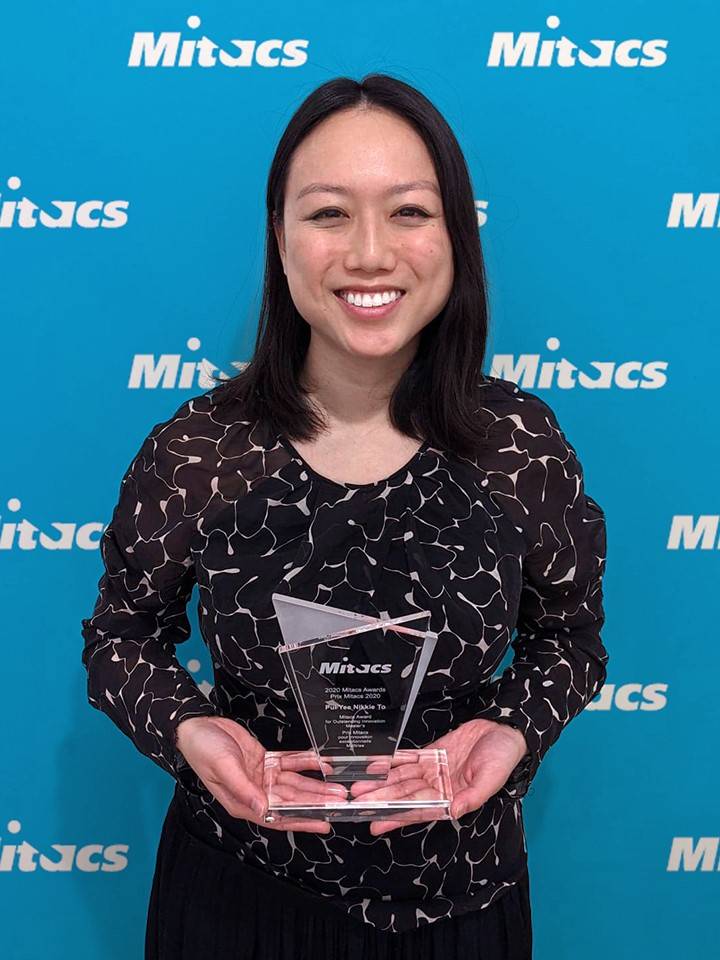OCAD U medal winner and Master of Inclusive Design grad, Pui Yee Nikkie To, has been awarded the Mitacs Award for Outstanding Innovation — Master’s.
To was recognized for her innovative work to help the more than 74,000 children and youth with special needs in Ontario by ensuring complex sensory needs are met when designing children’s treatment centres — a first for the sector.
Mitacs, a national innovation organization that fosters growth by solving business challenges with research solutions from academic institutions, presented the award in a virtual ceremony held today.
To, who studied at OCAD University under Associate Professor Maya Desai, was recognized for her novel design guidelines that show how sensory considerations can be incorporated within children’s treatment centre environments to promote positive experiences for those dealing with sensory processing disorder. The results of her research are filling a gap in the industry, she said.
“Most building codes deal with mobility and physical access but fail to address sensory and cognitive needs,” said To, who found that as many as 90 per cent of children with autism spectrum disorder, and five to 16 per cent of neurotypical children experience sensory processing disorder, which can negatively impact their balance, motor coordination and response to stimuli.
“My goal is to promote independence, diversity and respect within these centres by allowing children who have different sensory abilities to access spaces and information equally,” she added.
What’s unique about To’s approach — which is based on literature, as well as observation, interviews, and co-designs conducted at the Grandview Children’s Centre in Oshawa — is that it applies sensory attributes such as sight, sound, smell, position and touch.
Targeting five main categories — wayfinding and navigation, public gathering spaces and amenities, transitional spaces, treatment spaces and recreational spaces — her design recommendations include details such as well-placed multi-sensory maps to augment signage in hallways, painted floor areas or movable maps to help associate specific activities to specific spaces, and sensory walls, colours and murals to create learning opportunities outside of treatment rooms and classrooms.
“When you walk into a children’s centre and you’re trying to get from point A to point B, it’s not just about including a sign with an arrow pointing right. It’s about ensuring the information is presented through a variety of modalities,” she explained, noting that a navigational sign might provide auditory or visual feedback, or use colour or touch to help get the message across.
This past summer, To presented her Sensory Design Guidelines to Grandview Kids, their design team B+H Architects and Colliers project managers, who are responsible for planning Grandview Kids’ newest centre in Ajax, Ontario, as well as to Empowered Kids Ontario, Infrastructure Ontario and the Ontario Ministry of Children, Community and Social Services. The guidelines will be incorporated as requirements for consideration in the new building's design. She is also working to create a simplified and more accessible version of her guidelines that can be used to inform the design of existing centres or construct future centres.
The Mitacs Award for Outstanding Innovation — Master’s is presented to a Mitacs intern who has made a significant achievement in research and development innovation during their Mitacs-funded research.
To is one of eight Mitacs award winners nationally, chosen from thousands of researchers who take part in Mitacs programs each year. The remaining seven recipients were recognized for outstanding innovation, commercialization or exceptional leadership in other areas of research.
In congratulating the winners, Mitacs CEO and Scientific Director John Hepburn said Canada benefits from innovation derived from strategic partnership between industry, government and academia, ultimately helping to retain top talent on our home turf and spurring economic recovery.
“Whether our researchers study abroad and bring their expertise back to Canada, or develop groundbreaking ideas by tapping into resources across our country, their breakthrough work is changing the way we live and work,” Hepburn said. “Mitacs is honoured to play a role in supporting this important research and helping to advance innovation for the benefit of Canadians.”
